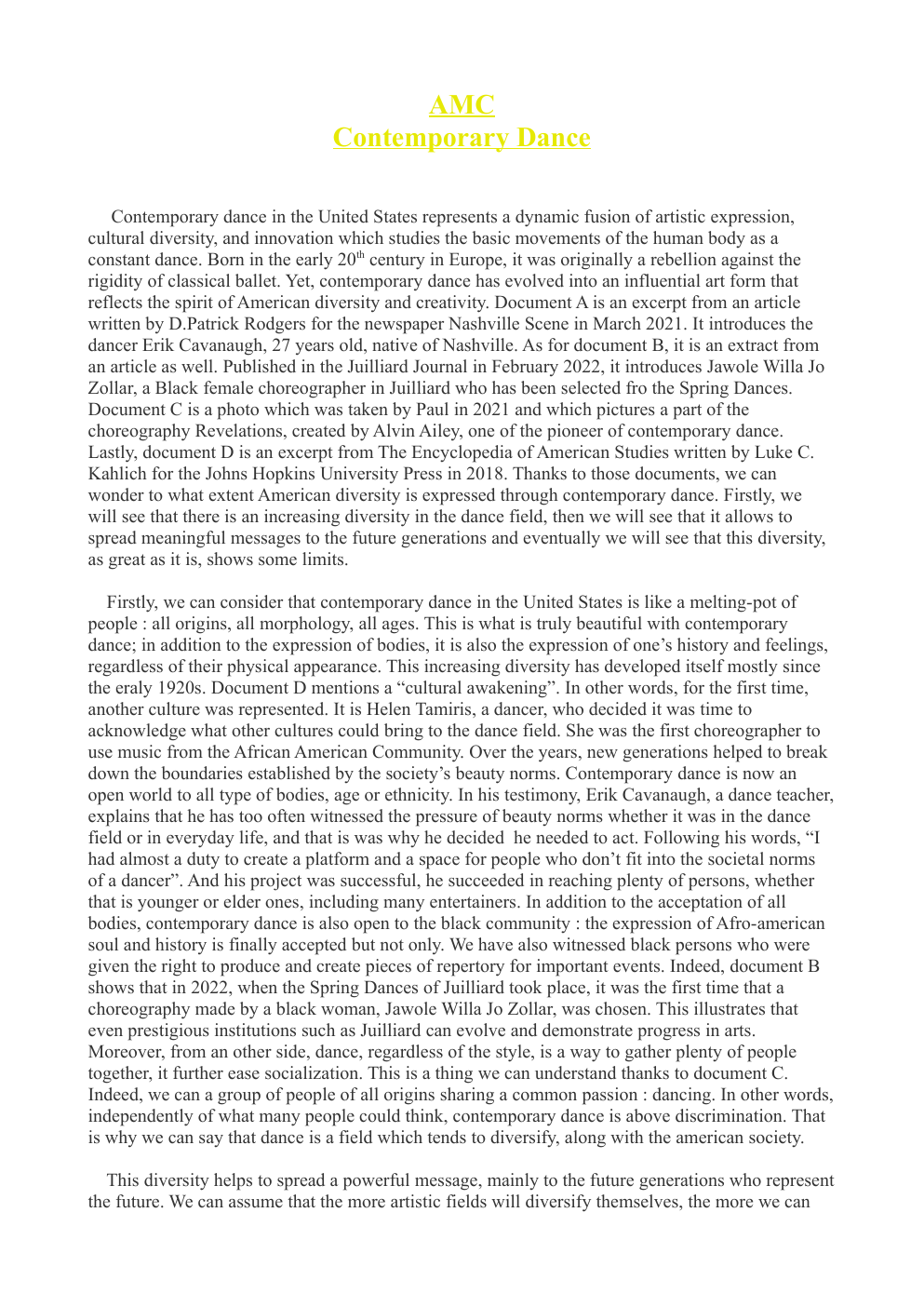Contemporary Dance - sujet type bac (amc)
Publié le 01/05/2024
Extrait du document
«
AMC
Contemporary Dance
Contemporary dance in the United States represents a dynamic fusion of artistic expression,
cultural diversity, and innovation which studies the basic movements of the human body as a
constant dance.
Born in the early 20th century in Europe, it was originally a rebellion against the
rigidity of classical ballet.
Yet, contemporary dance has evolved into an influential art form that
reflects the spirit of American diversity and creativity.
Document A is an excerpt from an article
written by D.Patrick Rodgers for the newspaper Nashville Scene in March 2021.
It introduces the
dancer Erik Cavanaugh, 27 years old, native of Nashville.
As for document B, it is an extract from
an article as well.
Published in the Juilliard Journal in February 2022, it introduces Jawole Willa Jo
Zollar, a Black female choreographer in Juilliard who has been selected fro the Spring Dances.
Document C is a photo which was taken by Paul in 2021 and which pictures a part of the
choreography Revelations, created by Alvin Ailey, one of the pioneer of contemporary dance.
Lastly, document D is an excerpt from The Encyclopedia of American Studies written by Luke C.
Kahlich for the Johns Hopkins University Press in 2018.
Thanks to those documents, we can
wonder to what extent American diversity is expressed through contemporary dance.
Firstly, we
will see that there is an increasing diversity in the dance field, then we will see that it allows to
spread meaningful messages to the future generations and eventually we will see that this diversity,
as great as it is, shows some limits.
Firstly, we can consider that contemporary dance in the United States is like a melting-pot of
people : all origins, all morphology, all ages.
This is what is truly beautiful with contemporary
dance; in addition to the expression of bodies, it is also the expression of one’s history and feelings,
regardless of their physical appearance.
This increasing diversity has developed itself mostly since
the eraly 1920s.
Document D mentions a “cultural awakening”.
In other words, for the first time,
another culture was represented.
It is Helen Tamiris, a dancer, who decided it was time to
acknowledge what other cultures could bring to the dance field.
She was the first choreographer to
use music from the African American Community.
Over the years, new generations helped to break
down the boundaries established by the society’s beauty norms.
Contemporary dance is now an
open world to all type of bodies, age or ethnicity.
In his testimony, Erik Cavanaugh, a dance teacher,
explains that he has too often witnessed the pressure of beauty norms whether it was in the dance
field or in everyday life, and that is was why he decided he needed to act.
Following his words, “I
had almost a duty to create a platform and a space for people who don’t fit into the societal norms
of a dancer”.
And his project was successful, he succeeded in reaching plenty of persons, whether
that is younger or elder ones, including many entertainers.
In addition to the acceptation of all
bodies, contemporary dance is also open to the black community : the expression of Afro-american
soul and history is finally accepted but not only.
We have also witnessed black persons who were
given the right to produce and create pieces of repertory for important events.
Indeed, document B
shows that in 2022, when the Spring Dances of Juilliard took place, it was the first time that a
choreography made by a black woman, Jawole Willa Jo Zollar, was chosen.
This illustrates that
even prestigious institutions such as Juilliard can evolve and demonstrate progress in arts.
Moreover, from an other side, dance, regardless of the style, is a way to gather plenty of people
together, it further ease socialization.
This is a thing we can understand thanks to document C.
Indeed, we can a....
»
↓↓↓ APERÇU DU DOCUMENT ↓↓↓
Liens utiles
- Sujet type bac : Visages de la contestation au XIXème siècle OE : L'Argumentation
- SUJET TYPE BAC Justice Sociale SES: Quelles inégalités sont compatibles avec les différentes conceptions de la justice sociale ?
- Grille d'évaluation d'un sujet de type bac
- allemand composition type bac
- Sujet type bac du devoir: Les enjeux transnationaux des conflits actuels


